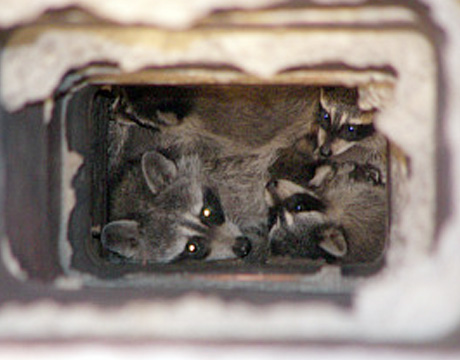 Exclusion is always the best method for preventing problems. Install and maintain a chimney cap before animals move into your chimney. When a fireplace is not in use make sure to close the flue, which prevents animals from entering your home.
Exclusion is always the best method for preventing problems. Install and maintain a chimney cap before animals move into your chimney. When a fireplace is not in use make sure to close the flue, which prevents animals from entering your home.
Den sites in chimneys are usually located on the smoke shelf in the fireplace flue. If you discover an established den in your chimney, use any of the techniques listed under the “Den sites” tab.
Important Note:
Do not try to "smoke out" animals. They can be overcome with smoke, and then you will be faced with physically removing a dead animal from your chimney.
Your goal is to make a potential den site unsuitable for the nesting animal before they settle in and start a family. Once an animal has newborns to protect, they will be less likely to evacuate. If the following deterrents are ineffective and an animal nests on your property, call a wildlife rehabilitator for advice.
Find information on wildlife rehabilitators and other professional wildlife services.
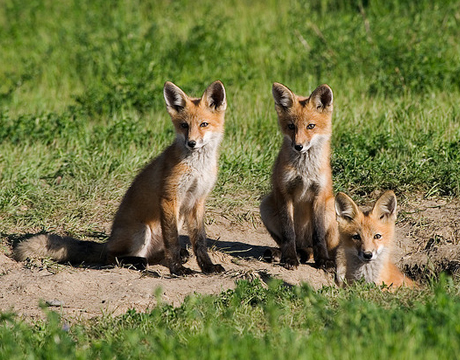 Lights
Lights
Disturb the animal's sleep by placing lights in or near the den. Try bright flashlights, flood lamps or blinking strands of holiday lights. It is best to leave the lights on 24 hours a day. If this is not possible, make sure they are on during the day for nocturnal animals such as raccoons, skunks, foxes, coyotes and opossums or during the night for squirrels, chipmunks, rabbits, voles and woodchucks.
Noise
Disturb the animal’s sleep by playing a portable radio, noisy children's toy or anything that makes noise repeatedly in or near the den. It is best to have the sound on for 24 hours a day. If this is not possible, make sure they are on during the day for nocturnal animals such as raccoons, skunks, foxes, coyotes and opossums or during the night for squirrels, chipmunks, rabbits, voles and woodchucks.
Odor
Place rags soaked in ammonia in or near the den for one week. Ammonia has an irritating smell. Over time, the ammonia will dissipate so it is important to re-soak the rags daily.
Important Note:
Do not use ammonia-soaked rags from March through August. The fumes may injure infant animals that are too young to remove themselves from the area.
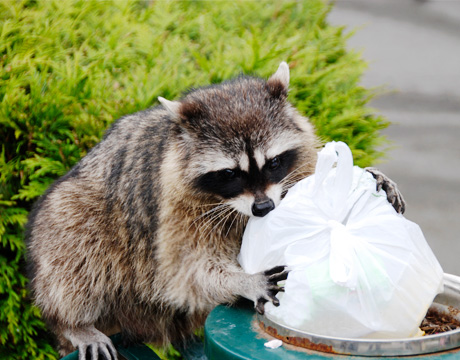 The simplest solution to keep animals out of your garbage cans is to bring the cans inside where animals cannot reach them. If this is not possible, keep the cans in a secured area or sprinkle black pepper on the top bag inside the can. Another deterrent is to place rags soaked in ammonia on top of the lid and secure with bungee cords. Use an odor deterrent for one week after you notice issues or when putting garbage outside for weekly pickup.
The simplest solution to keep animals out of your garbage cans is to bring the cans inside where animals cannot reach them. If this is not possible, keep the cans in a secured area or sprinkle black pepper on the top bag inside the can. Another deterrent is to place rags soaked in ammonia on top of the lid and secure with bungee cords. Use an odor deterrent for one week after you notice issues or when putting garbage outside for weekly pickup.
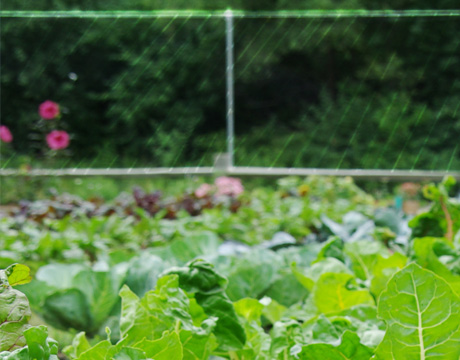 Garden
Garden
Exclusion is always the best method for preventing problems. A four-foot-high chicken wire fence will do the trick for small to medium animals and small areas. Leave the top twelve to 18 inches unattached to any support and bent outward. The animal's weight will pull the fence downward, landing back where it started. If deer are causing damage to a garden, a fence at least eight feet tall and constructed of strong, impenetrable material is needed.
Taste deterrents may work with small animals such as chipmunks, squirrels and voles. However, they need to be reapplied after a heavy dew or rain. Some animals can develop a taste for spicier food over time, so varying deterrents may help. Check a local nursery or home center for commercial products or try one of these homemade deterrents:
-
Spray a mixture of water and hot sauce (one gallon to two tablespoons) onto plants
-
Spray a garlic puree onto plants
-
Sprinkle baby powder on plants
Lawn
Skunks and raccoons are attracted to grubs and may damage lawns in search of food. Cayenne pepper or rags soaked in ammonia can be placed in the affected area to deter digging.
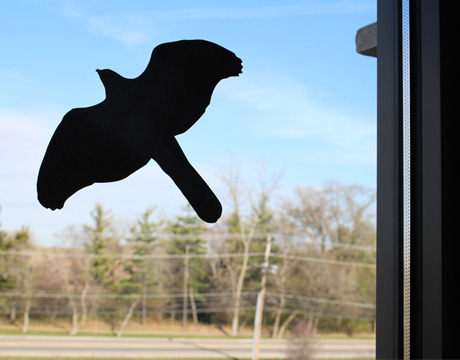 Windows
Windows
Is your home safe for birds? The Audubon Society estimates that as many as a billion birds die each year in the United States due to window collisions. One common cause of daytime window collisions is the reflection. A bird may interpret a reflection as a continuation of the landscape. Some species, such as northern cardinals, may repeatedly attack a window in a territorial attempt to drive away the “other bird.” Reduce reflection-related collisions by applying window clings, hanging brightly colored ribbons in front of the windows, or attaching a hawk silhouette to the glass.
If a bird does strike your window and cannot fly away place it in a box with air holes. Occasionally open the box to allow the bird to fly out. If it does not fly away it is possibly still in shock and may need several hours to recover. Attempt to release the bird again. If it still fails to fly out call a wildlife rehabilitator for advice.
Find information on wildlife rehabilitators, migratory bird safety, and minimizing window collisions.
Window Wells
Exclusion is always the best method for preventing problems. Install and maintain a window well cover before animals can fall into them.
Very few animals will establish a permanent home in a window well. Most wildlife, such as a reptiles or amphibians, found in a window well has entered by mistake. If you find an animal in your window well, it is likely that it cannot escape. Assist it by lowering a rough-surfaced board tacked with burlap or carpet scraps into the window well at an angle and leave the area. Nocturnal animals will climb out after dark.
Important Note:
The 1918 Migratory Bird Treaty Act protects all native birds. It is illegal for any person to possess birds, dead or alive, nesting material, eggs, feathers and bones of a bird without the proper permits from the United States Fish & Wildlife Service (USFWS) and the State of Illinois. It is illegal to harm or kill a protected bird species. It is also illegal to remove or destroy nesting material from a nest once an egg has been laid. Contact the USFWS for additional information on the 1918 Migratory Bird Treaty Act.